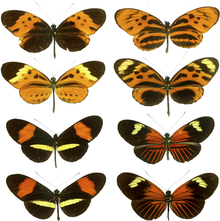
In biology, a species complex is a group of closely related organisms that are so similar in appearance and other features that the boundaries between them are often unclear. The taxa in the complex may be able to hybridize readily with each other, further blurring any distinctions. Terms that are sometimes used synonymously but have more precise meanings are cryptic species for two or more species hidden under one species name, sibling species for two (or more) species that are each other's closest relative, and species flock for a group of closely related species that live in the same habitat. As informal taxonomic ranks, species group, species aggregate, macrospecies, and superspecies are also in use.
Two or more taxa that were once considered conspecific (of the same species) may later be subdivided into infraspecific taxa (taxa within a species, such as bacterial strains or plant varieties), which may be a complex ranking but it is not a species complex. In most cases, a species complex is a monophyletic group of species with a common ancestor, but there are exceptions. It may represent an early stage after speciation in which the species were separated for a long time period without evolving morphological differences. Hybrid speciation can be a component in the evolution of a species complex.
Species complexes are ubiquitous and are identified by the rigorous study of differences between individual species that uses minute morphological details, tests of reproductive isolation, or DNA-based methods, such as molecular phylogenetics and DNA barcoding. The existence of extremely similar species may cause local and global species diversity to be underestimated. The recognition of similar-but-distinct species is important for disease and pest control and in conservation biology although the drawing of dividing lines between species can be inherently difficult.